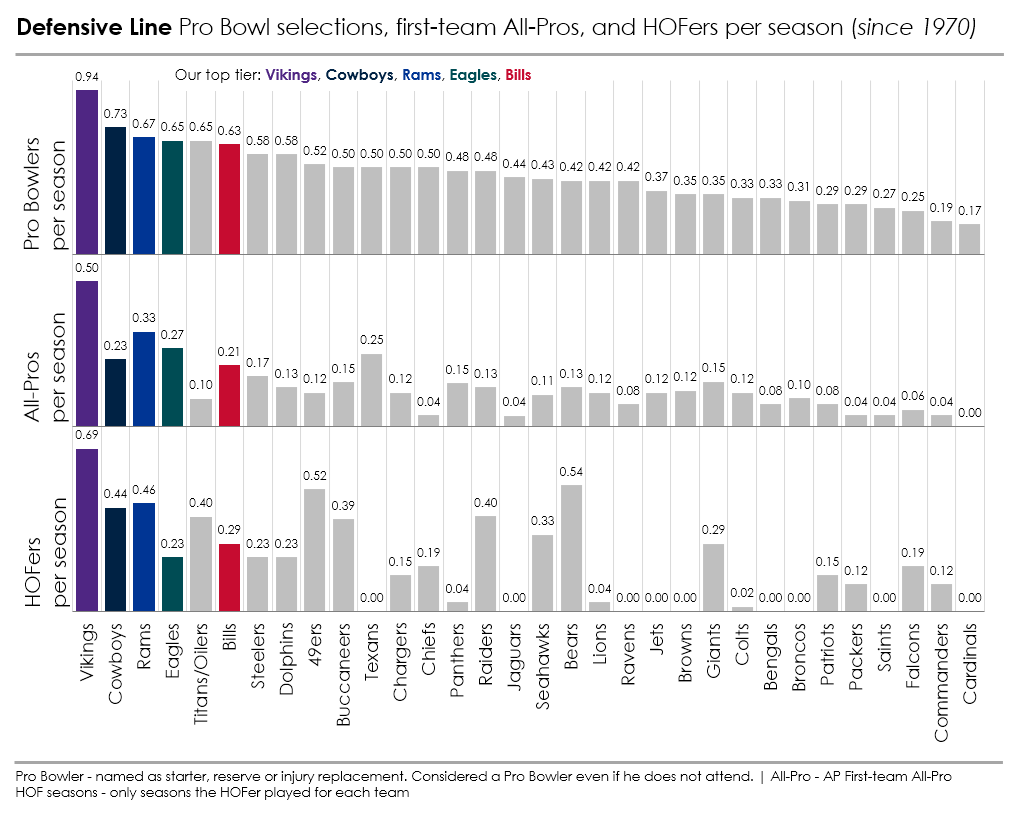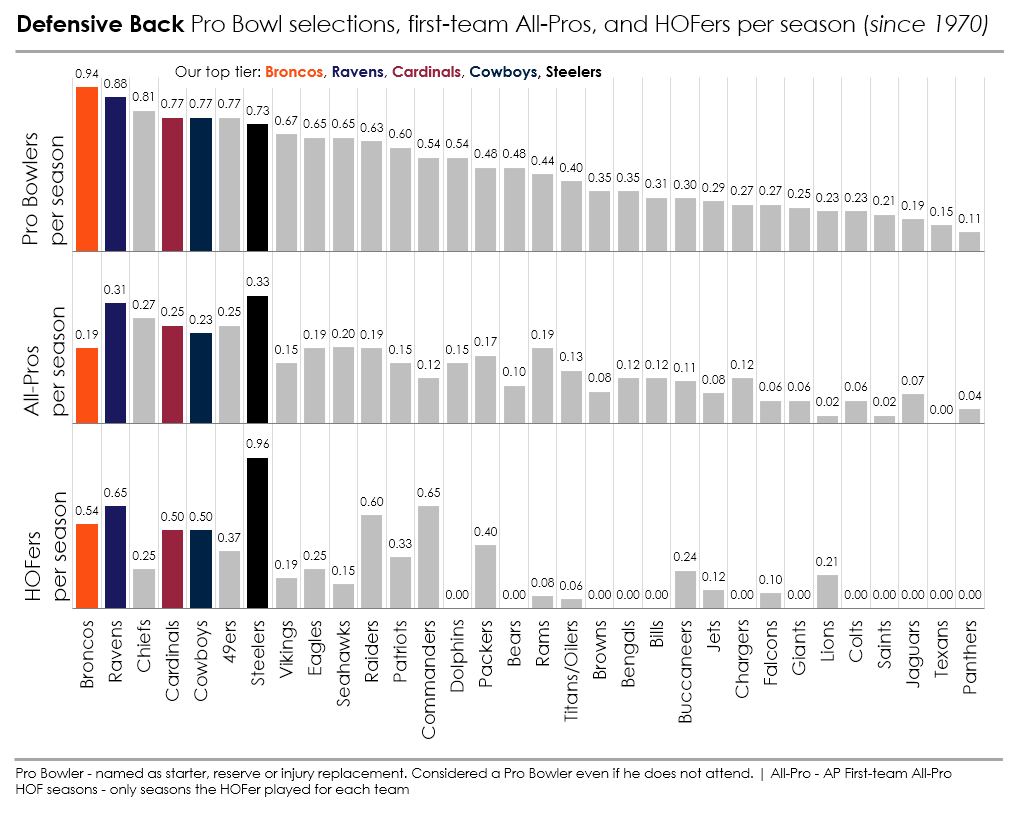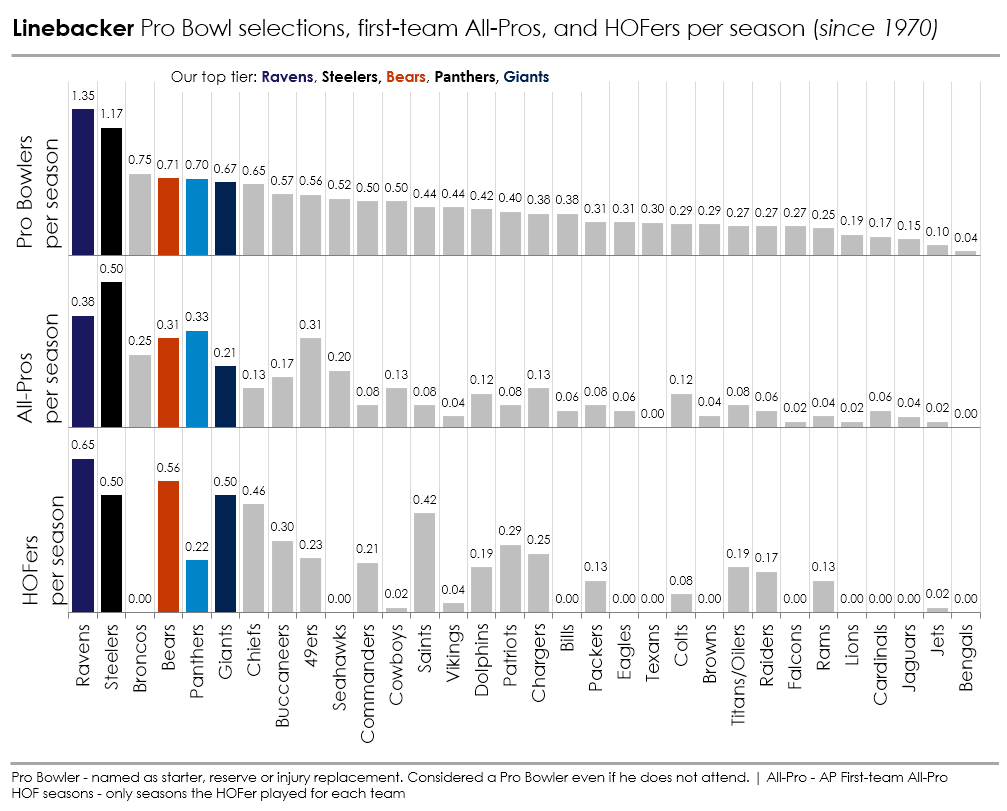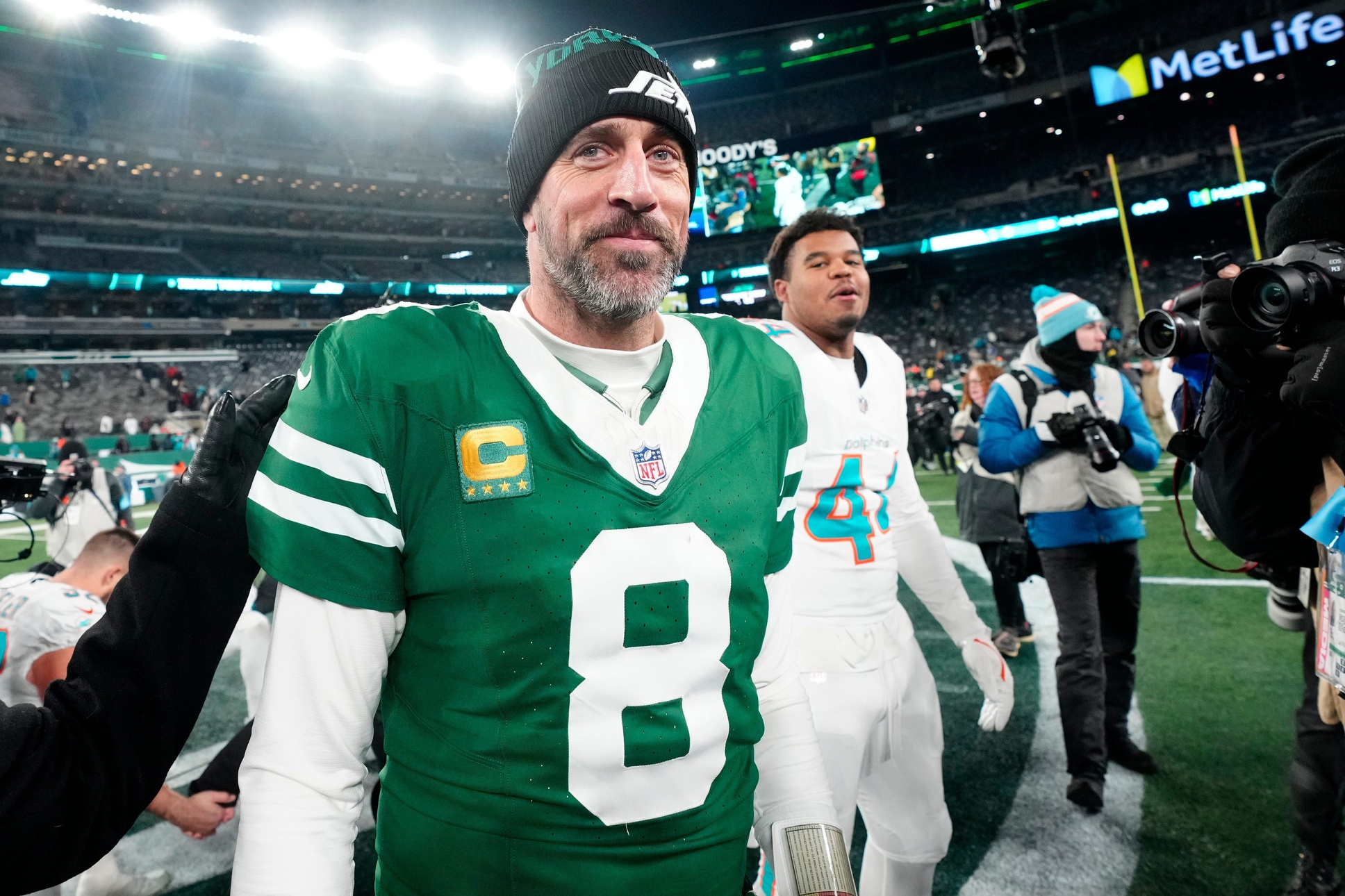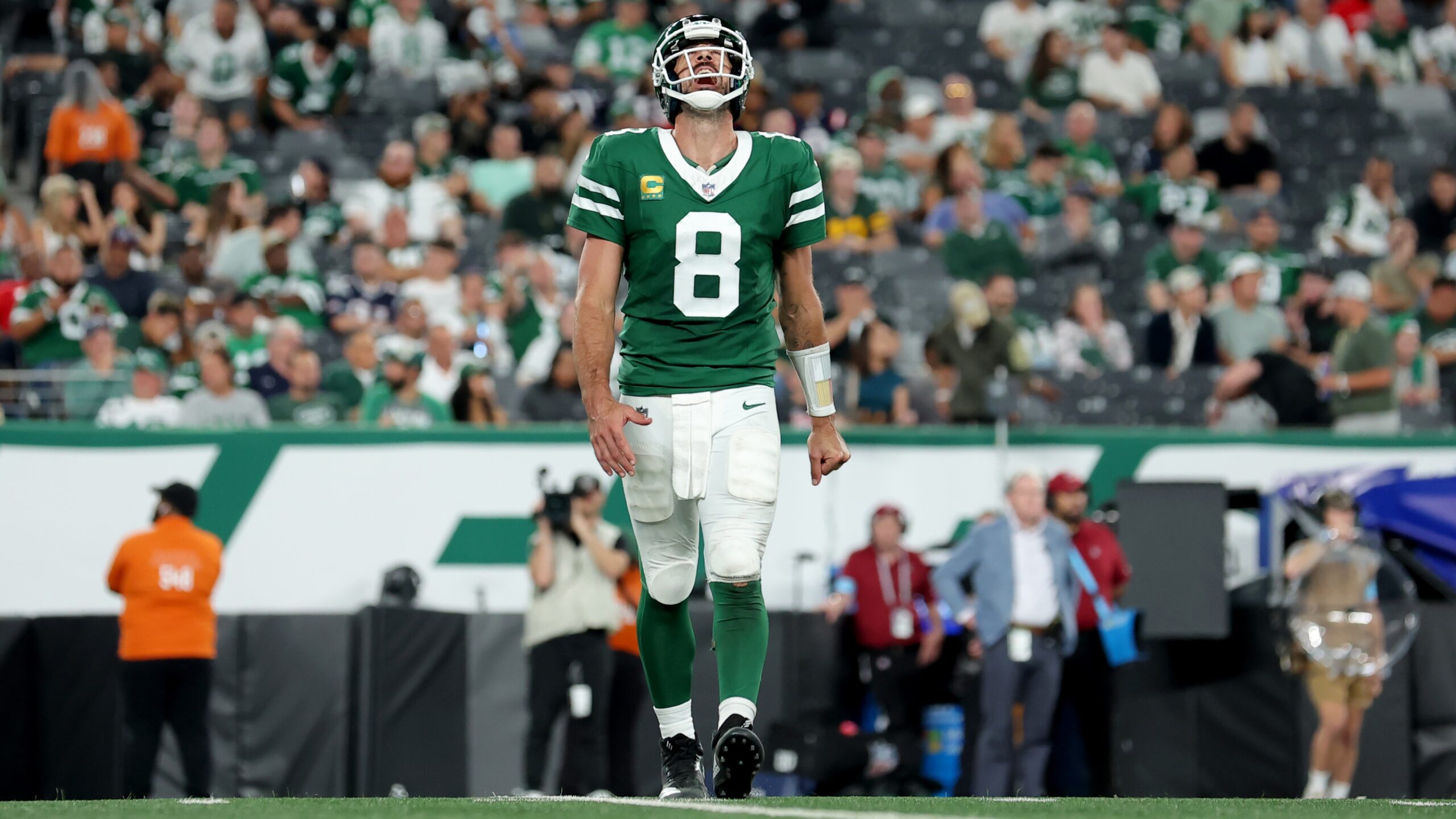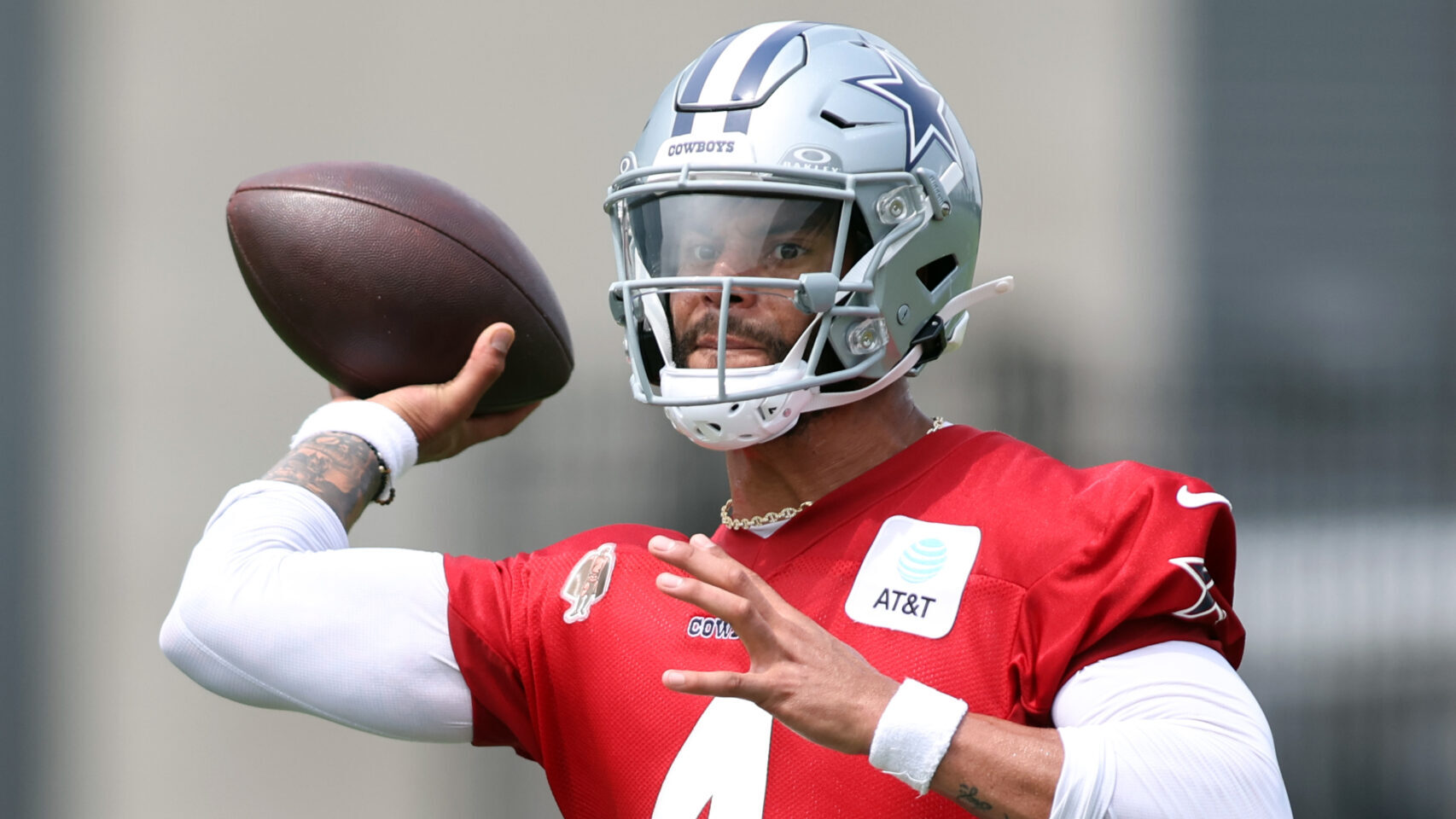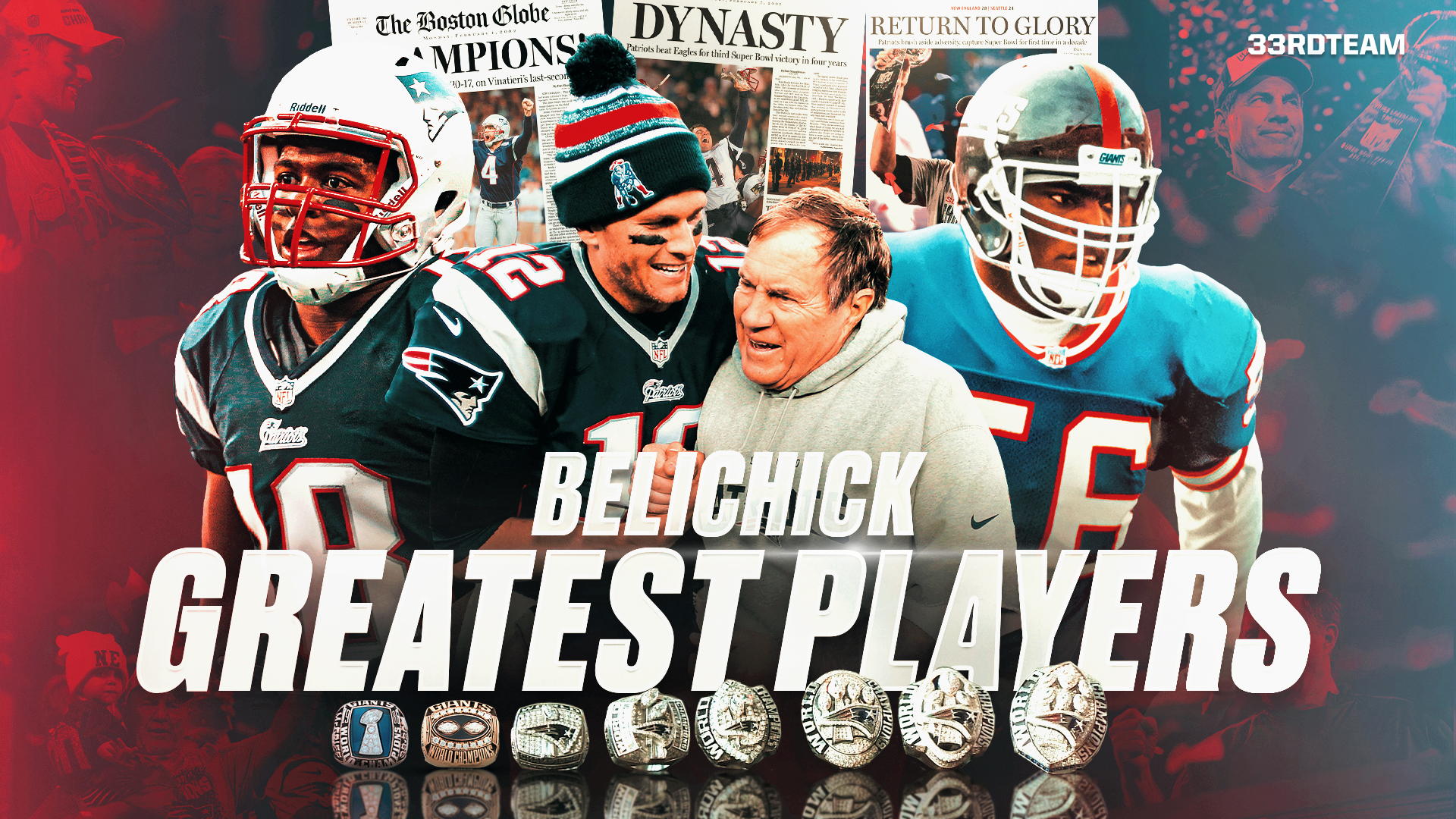Analysis
7/18/22
15 min read
Which NFL Teams Have the Greatest Legacy at Each Defensive Position?
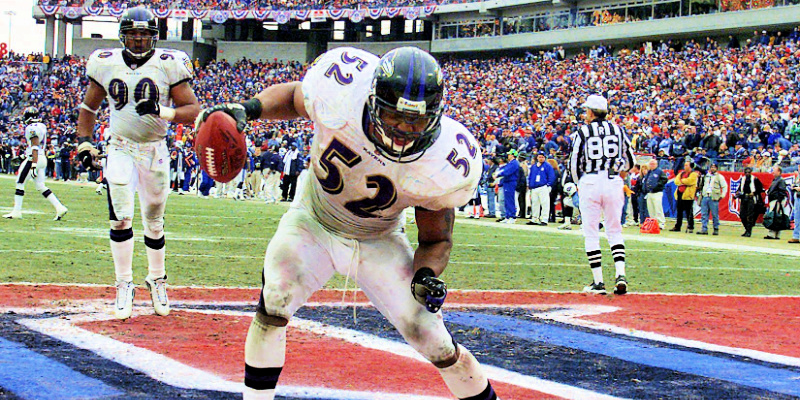
When you think of the team with the best legacy at linebacker, do you think of the Monsters of the Midway…the lineage in Chicago going from Dick Butkus to Mike Singletary to Brian Urlacher? At defensive line, perhaps your thoughts wander to the Vikings’ history of playmakers, starting with the Purple People Eaters and continuing with guys like John Randle and Chris Doleman who terrorized offensive lines decade after decade.
It’s hard to not think about those great Steelers teams of the 70s and their defensive backfield with Mel Blount and Donnie Shell, and years later, Rod Woodson and Troy Polamalu. For this analysis, we combed through the data from 1970 to present and calculated the average annual number of Pro Bowlers, first-team AP All-Pros, and Hall of Famers grouped by franchise and by positional group (linebackers, defensive backs, and defensive line) to help determine which teams were the best at each position. The teams we listed are the teams we believe are the most dominant at their positional groups within the past 50+ years. They are packed with big names, accolades, interesting characters, and in most cases, winning traditions.
Notes:
- Sack totals before 1982 are the unofficial sack numbers recently added to Pro Football Reference
- All references to All-Pro are first-team Associated Press All-Pro only
- HOF seasons for each team are tabulated only from the season the player played for each team (example: Washington gets 5 Champ Bailey seasons, Denver gets 10)
Defensive Line
Vikings
A defensive unit doesn’t earn the moniker The Purple People Eaters unless they are one of the most commanding and fearsome fronts in the NFL. The Vikings’ dominant legacy on the defensive line stems from the 1970s but it doesn’t end there. From 1970-1976, the Vikings had a top five defense in points allowed as they went 75-22-1 and made three Super Bowl appearances. The line was anchored by two Hall of Famers in Carl Eller and future Minnesota Supreme Court Justice Alan Page.
In the late ‘80s and ‘90s, two more HOFers Chris Doleman and John Randle would continue the tradition that the Purple People Eaters began in the late ‘60s. Doleman ended his career with 150.5 sacks, which is the 7th most in NFL history. The four Hall of Famers, Doleman, Randle, Eller, and Page, plus 4-time AP All-Pro Jared Allen, combined for a total of 706 sacks and make up 25% of the top-20 list for career sacks. Kevin Williams, a 300+ pound run stuffer who could also get after the quarterback (career best 11.5 sacks in 2004), was the linchpin of the defensive line in the early to late 2000s. He would go on to make six Pro Bowls and earn five AP All-Pros.
All in all, the Vikings had a HOF defensive lineman on their roster 44% of the time since the merger, and in thirteen of the 52 years, they had two HOFers on the D-line, while averaging nearly one Pro Bowler every season.
Rams
Deacon Jones was arguably one of the most feared players in NFL history, and although most of his dominance was in the 1960s when he had three seasons with 20+ sacks, he kicked off the post-merger Rams era with a Pro Bowl season at the age of 32. He wouldn’t do much for the Rams after his 1970 season, but he set the stage for the rest of the decade in which the Rams would have a top 5 defense for points allowed in seven of the 10 years.
The Rams never won a Super Bowl in the ‘70s, but they would make the Conference Championship half of the time. The Rams often had at least one HOFer on the defensive line every single season during the 1970s. In 1971, their defensive line had THREE HOFers in Deacon Jones, Jack Youngblood, and Merlin Olsen. Although 1971 was Jones’ last season with the Rams, Olsen and Youngblood continued to terrorize opponents throughout the decade and racked up 13 Pro Bowls and six AP All-Pros. Book-ending this reign of terror is certain future Hall of Famer Aaron Donald, who came up big in the final moments of Super Bowl LVI by stopping the Bengals on their final drive for no gain on 3rd and one and then pressuring QB Joe Burrow into an errant throw on 4th and one before jumping to his feet and pointing to his ring finger as the Rams won the Super Bowl.
Donald has known nothing but accolades and awards since he entered the league, including Defensive Rookie of the Year, a Pro Bowl in each of his eight seasons, seven AP All-Pros and three AP Defensive Player of the Year awards. Jones (173.5 sacks) and Youngblood (151.5 sacks) are ranked 3rd and 6th all time, while Donald leads all players in sacks with 98 since he has entered the league.
Cowboys
Offense wins games, defense wins championships. Although this phrase doesn’t apply in the modern NFL, there is always a thread of truth to a common adage and the Cowboys exemplify this saying. From 1970 to 1995, the Cowboys participated in eight Super Bowls, winning five, and their defense was never outside of the top 10 during those Super Bowl years.
Their success was, in part, due to having an overabundance of great defensive lineman. The Cowboys never went to a Super Bowl without a Hall of Fame defensive lineman. HOFer Bob Lilly (Dallas from 1961-1974) went to two Super Bowls, HOFer Randy White (Dallas from 1975-1988) went to three Super Bowls, and, in a short 5-year stint with the Cowboys, HOFer Charles Haley won three Super Bowls while anchoring a defense that averaged the third fewest points per season.
Since their last Super Bowl in 1996, the Cowboys have had their share of Pro Bowlers with players like La'Roi Glover, Jay Ratliff, and DeMarcus Lawrence, but it is the ‘70s, ‘80s and ‘90s that really carry their legacy at the defensive line position.
A case can be made for…
Bills
Key Players: Bruce Smith (HOF, career sacks leader), Kyle Williams, Fred Smerlas, Marcell Dareus
Eagles
Key Players: Reggie White (HOF, 2nd all-time in career sacks) Fletcher Cox, Charlie Johnson, Hugh Douglas
Defensive Back
Ravens
The Ravens may benefit from being a newer team and have played half the number of years (26) compared to most teams (52) since the merger. Smaller sample sizes allow for more anomalous results, but for the defensive back and linebacker units, they have managed to stuff 52 years’ worth of Pro Bowlers, All-Pros and HOFers into their 26 years in the league.
The Ravens top tier ranking is heavily influenced by the safety position in which they have had a Pro Bowler in 17 of their 26 seasons. HOFers Ed Reed and Rod Woodson combined for 12 Pro Bowls with the Ravens, and Eric Weddle made three in a row from 2016-2018.
Ed Reed is one of the two most dominant players in Ravens history with nine Pro Bowls, four AP All-Pros, a DPOY award in 2004 and more interception return yards (1,590) than any other player in NFL history. Woodson who had 71 career interceptions and Ed Reed who had 64 are ranked #3 and #7 all time in picks. Much of Woodson’s damage came with the Steelers as a CB, but he managed three Pro Bowl selections with the Ravens from ages 34-36 after being converted to a safety. Current All-Pro cornerbacks Marlon Humphrey and Marcus Peters hope to build on the strong defensive back legacy of the Ravens as they come back from recent injuries.
Steelers
When a team goes 27 consecutive seasons with a Hall of Famer in the defensive backfield, like the Steelers did from 1970 to 1996, they’re going to win a lot.
The Steelers’ record during this time was 245-162-1, while winning four of five Super Bowls. For those 27 years, the Steelers were never without a HOFer on their roster which included Mel Blount, Donnie Shell, or Rod Woodson. Rod Woodson, 1993 DPOY, mentioned above in the Ravens section, is second all-time in Pro Bowls (11) and All-Pros (6) for defensive backs, with most of those accolades coming from his time with the Steelers. In 1975, Mel Blount distinguished himself from a team that was stacked with Hall of Famers and had eight Pro Bowl players on defense to win the AP Defensive Player of the Year.
Blount and Shell combined for 10 Pro Bowls and five AP first-team All-Pros. HOFer Troy Polamalu would be the third Steeler DB to win AP Defensive Player of the Year in 2010. No other team has won as many DPOY awards by their defensive backs as the Steelers have.
Today, the Steelers have two time first-team All-Pro Minkah Fitzpatrick ,who will be only 26 years old this season and entering his prime. His 124 combined tackles in 2021 led all defensive backs. The Steelers’ rate of having an All-Pro defensive back an average of every three years and a HOF defensive back nearly every year are both ranked number one in the NFL since 1970.
Broncos
No team in the NFL has had more defensive backs selected to the Pro Bowl since the merger than the Broncos. In 52 seasons, the Broncos’ defensive backs made the Pro Bowl 49 times from a total of 14 different players, led by Hall of Famers Steve Atwater and Champ Bailey with eight each. Louis Wright and Bill Thompson of the famed Orange Crush defense in the late ‘70s and early ‘80s were multiple-time Pro Bowlers for a team that was in the top five for points allowed each season from 1977-1979.
More recently, Chris Harris Jr. and Aqib Talib both made the Pro Bowl nearly every season from 2014-2018, including 2015, when the Broncos won the Super Bowl and were number one in the NFL in fewest yards allowed. Hard-hitting safety Steve Atwater missed only five games in his 10 seasons with the Broncos. His Broncos career began with a Super Bowl loss and ended with two consecutive Super Bowl wins in the 1997 and 1998 seasons.
Champ Bailey came over to the Broncos from Washington in 2004 and strung together three consecutive AP All-Pro seasons, with his best year coming in 2006 when he led the NFL in interceptions (10) and was runner-up for DPOY. Combined with his time in Washington, Bailey had more Pro Bowl selections (12) than any other defensive back since the merger.
Hall of Famers Brian Dawkins and John Lynch both joined the Broncos in the twilight of their careers, but they both combined to make seven Pro Bowls in their mid to late 30s in Denver. While the Broncos’ defensive back legacy may not have been as superior as the Steelers’ and Ravens’, they make the top tier due to the sheer volume of DBs who have been recognized as one of the best in the league year-in and year-out.
A case can be made for…
Cardinals
Key Players: Roger Wehrli (HOF), Aeneas Williams (HOF), Patrick Peterson, Adrian Wilson, Budda Baker
Cowboys
Key Players: Deion Sanders (HOF), Cliff Harris (HOF), Mel Renfro (HOF), Darren Woodson, Roy Williams, Everson Walls
Linebacker
Ravens
While the annual honors for the Ravens stand out, their top tier ranking comes with the caveat that it’s primarily the result of having arguably the greatest linebacker in history for 17 of their short tenure of 26 years in the league. Ray Lewis, the Ravens’ only current HOF linebacker, is tied for the most first-team All-Pro selections for a linebacker since the merger (Junior Seau is the other LB with 12 All-Pros). He is a two-time AP Defensive Player of the year, a Super Bowl MVP and his 2,059 career combined tackles is the most in the NFL dating back to 1994, which is the earliest date for this statistic per Pro Football Reference. In his 2000 season, on their way to winning the Super Bowl, the Ravens set the record for fewest points allowed in a 16-game season (165) and fewest rushing yards against (970), while opponents averaged only 2.7 yards per carry.
Terrell Suggs, a hybrid DE/OLB who has a chance of joining Lewis in the HOF someday, started his 16-year career by winning AP Defensive Rookie of the Year in 2003, and won AP Defensive Player of the Year eight years later. Suggs’ and Lewis’ careers would overlap for 10 years (2003-2012) and during that time the Ravens were a top five defense in yards allowed six times and were a top 10 defense in yards allowed nine times.
Their final season together in 2012 culminated with a Super Bowl win. The Ravens’ linebacking corps was also peppered with other quality linebackers like Adalius Thomas (1 AP-All-Pro), DE/LB hybrid Elvis Dumervil (1 AP All-Pro), C.J. Mosley, and Peter Boulware, but it is Ray Lewis, arguably the best Linebacker ever, who is synonymous with the Ravens’ rich legacy at the linebacker position.
Steelers
When you hear the words “Steelers” and “Linebacker,” the most likely image in your mind is #58, Jack Lambert and his toothless scowl. Lambert’s greatness was quickly apparent in his rookie year when he started all 14 games and won the Defensive Rookie of the Year. Two years later, he was a first-team All-Pro, recovered a league-leading eight fumbles and won Defensive Player of the Year.
A few seasons before Jack Lambert was drafted by the Steelers, Jack Ham began his career. By Ham’s third year, he would make his first of eight Pro Bowls, and by his fourth season, he was an AP All-Pro, his first of six. It was when the Jacks were together on the field that the Steelers reached their defensive heights. Lambert and Ham played together from 1974 to 1982, and during those nine years, the Steelers won four Super Bowls. They had the number one scoring defense twice and a top five scoring defense six times. Ham and Lambert would each end up with six career first-team All-Pros, the fourth most for a linebacker since the merger. The Steelers dominance didn’t end with 4-time Super Bowl Champions from the ‘70s. The legacy simply began in the ‘70s and continued into the ‘80s, ‘90s and 2000s, with perennial Pro Bowler Greg Lloyd and two-time Super Bowl champion James Harrison.
Now, T.J. Watt takes the mantle. Watt is on a trajectory which may end up with him being the best of the group. Going into his sixth season, he has already won a Defensive Player of the Year, made four Pro Bowls, and made three first-team All-Pros. Watt has led the NFL in sacks and tackles for loss in each of the last two seasons, and he has tied Michael Strahan for the official single-season sack record of 22.5 (0.5 sacks behind Al “Bubba” Baker’s unofficial record of 23.0).
In 12% of the Steelers’ seasons since the merger, they have been the number one scoring defense and top five scoring defense 38% of the time. The storied linebacker group has been a large part of the Steelers’ defensive success and winning tradition.
Bears
For nine years, running backs would shudder at the thought of going up against middle linebacker Dick Butkus and his combination of speed, size, power, and anger. Most of his career was before the merger, but his crippling tackles terrified running backs until 1973 when a lingering knee injury finally took its toll and ended his career. Despite this, the Hall of Fame linebacker packed a lot of honors into his nine years with eight Pro Bowls and five first-team All-Pros.
Chicago had to wait eight years before another Hall of Fame middle linebacker emerged with Mike Singletary drafted in 1981. Singletary had more AP first-team All-Pro seasons (7) than all linebackers since the merger except for Lawrence Taylor (8). He won his first of two NFL Defensive Player of the Year awards in 1985 when the Bears won the Super Bowl, wreaking havoc with their famed 46 Defense. That 1985 Bears’ defense led the NFL in fewest points and fewest yards allowed, while allowing their three playoff opponents to score only 10 total points enroute to winning the Super Bowl.
After Singletary retired, the Bears only had to wait another eight years for the next HOF middle linebacker Brian Urlacher. Urlacher was the pillar of two number one ranked defenses in the NFL in points allowed and amassed 138 career tackles for loss (11th most in history) per Pro Football Reference.
These three players gave Chicago a HOF linebacker in 29 total seasons since the merger, which is more than any other team in the NFL. The legacy of the Monsters of the Midway has continued with Lance Briggs, Khalil Mack, and now Roquan Smith, who has more solo tackles (348) than any other player in the league since his rookie year in 2018.
A case can be made for…
Giants
Key Players: Lawrence Taylor (HOF), Harry Carson (HOF), Brad Van Pelt, Jessie Armstead
Panthers
Key Players: Luke Kuechly, Kevin Greene (HOF), Sam Mills (HOF), Thomas Davis, Jon Beason
In part two of this series, we will take another deep dive into positional excellence as we shift to the offensive side of the ball, exploring the quarterback, offensive line, running back, and wide receiver/tight end groups.

